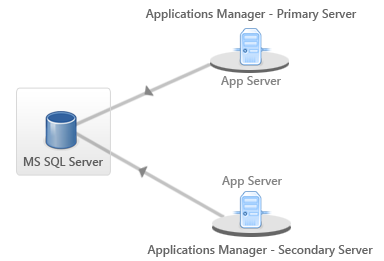Follow the steps below to implement failover support in ManageEngine Applications Manager:
The setup involves a primary Applications Manager, a secondary Applications Manager and a common database. The primary and secondary Applications Manager refer to the common database only. While the primary Applications Manager talks with the database, the secondary Applications Manager simply listens to the database. If the primary server goes down, the secondary server takes over. Afterwards, the initial primary server is restarted and it starts functioning as a secondary server.
Before installing failover (for Managed Servers):
|
Let us assume we are going to set up three nodes - node1, node2 and node3.
Applications Manager: node1, node2
MSSQL Database: node3

When node1Applications Manager goes down, node2Applications Manager will act as secondary server.
| Sample Nohup Output INFO | jvm 1 | 2013/08/05 01:00:06 | Checking for the availablity of the Primary Server in the Database. Found an entry. INFO | jvm 1 | 2013/08/05 01:00:06 | INFO | jvm 1 | 2013/08/05 01:00:06 | Trying to connect to the Primary Server at 192.168.1.3 INFO | jvm 1 | 2013/08/05 01:00:06 | INFO | jvm 1 | 2013/08/05 01:00:07 | Please wait ... INFO | jvm 1 | 2013/08/05 01:00:08 | ....Connected INFO | jvm 1 | 2013/08/05 01:00:08 | INFO | jvm 1 | 2013/08/05 01:00:08 | INFO | jvm 1 | 2013/08/05 01:00:08 | Starting AdventNet Web NMS Standby Server. The Modules will be started once it takes over as the Primary Server. INFO | jvm 1 | 2013/08/05 01:00:08 | INFO | jvm 1 | 2013/08/05 01:00:08 | Monitoring the Primary Server at 192.168.1.3 When node1Applications Manager goes down, node2Applications Manager will start up completely and will act as secondary server. Email notifications will be triggered on occurrence of a failover where you have to correct the issues with the node that is down. Then start it back as secondary which will now listen for another failure. INFO | jvm 1 | 2013/08/05 01:09:47 | Monitoring the Primary Server at 192.168.1.3INFO | jvm 1 | 2013/08/05 01:10:48 | Starting to do FailOver Tasks. INFO | jvm 1 | 2013/08/05 01:11:08 | Process : AlertFE [ Started ] INFO | jvm 1 | 2013/08/05 01:11:08 | Process : NmsMainFE [ Started ] INFO | jvm 1 | 2013/08/05 01:11:08 | INFO | jvm 1 | 2013/08/05 01:11:08 | Verifying connection with web server... verified INFO | jvm 1 | 2013/08/05 01:11:08 | INFO | jvm 1 | 2013/08/05 01:11:08 | Applications Manager started successfully. INFO | jvm 1 | 2013/08/05 01:11:08 | INFO | jvm 1 | 2013/08/05 01:11:08 | Please connect your client to the web server on port: 9095 INFO | jvm 1 | 2013/08/05 01:11:08 | INFO | jvm 1 | 2013/08/05 01:11:09 | The new primary server is 192.168.1.4 Note: Above steps need to be implemented for each installation in the Enterprise setup for failover. |